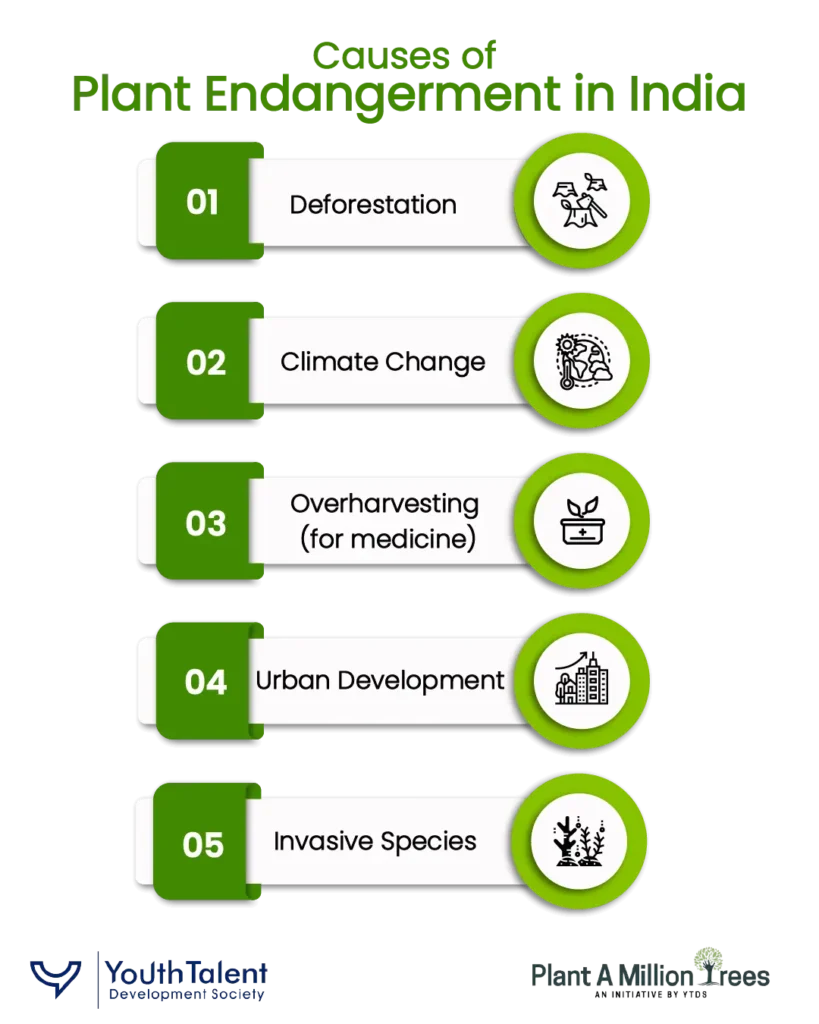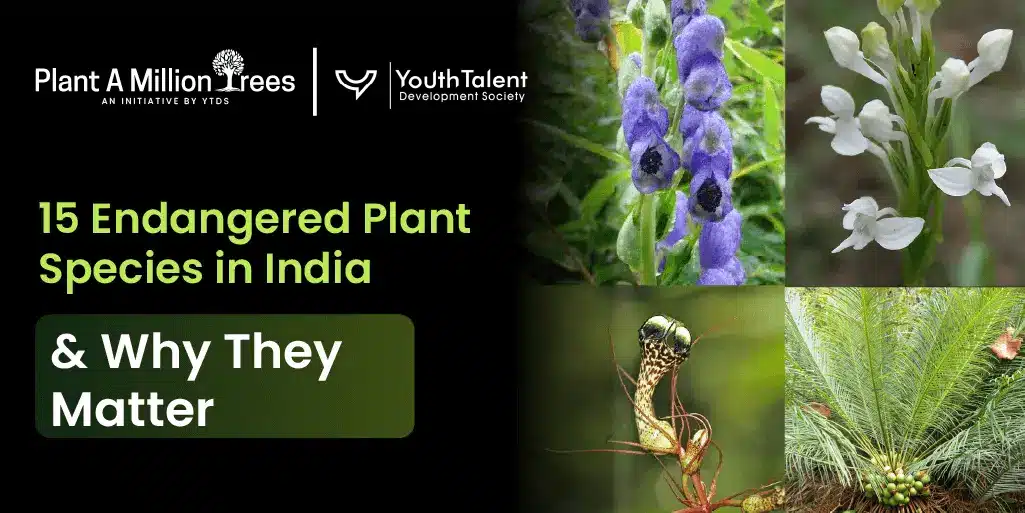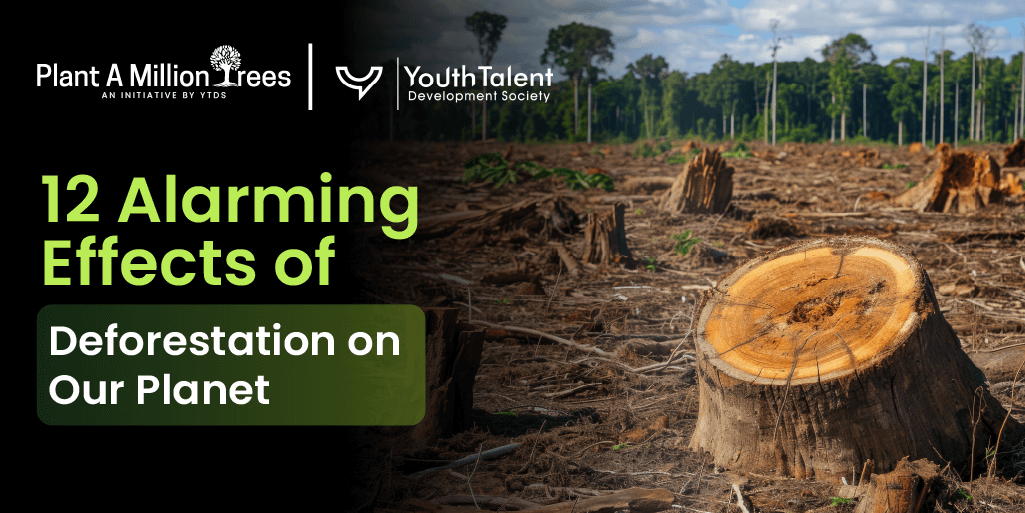Cutting trees on a massive scale has made deforestation a top environmental priority, both at the local and global...
The country is considered one of the most botanically diverse countries in the world with more than 18,000 species of flowering plants being native to India.
Nevertheless, some of these species are disappearing without a sound- some are at extinction threshold. The IUCN list India and the Ministry of Environment, Forest and Climate Change (MoEFCC) has been repeatedly warning of the endangered position of the plant species in India, of which, there has never been so much need, to learn and preserve.
These species do not only represent botanical strange phenomena, but help to maintain ecosystems and medical history, food structure, and biodiversity proportion.
This blog discusses the reasons behind, the present state of affairs and relevance of the endangered fauna of India, with a detailed list of the endangered plant species in India which are rare, those that are threatened and the critically endangered variety.
Understanding Endangered Plants
An endangered plant is bound to go extinct in the wild, with the risk being very high. Plants are classified in the IUCN (International Union for Conservation of Nature) into levels of threat, including Critically Endangered, Endangered, Vulnerable and Near Threatened depending on the criteria which include the size of the population, the range of the habitat and the rate of decline.
In Indian scenario the Botanical Survey of India preserves these categories in collaboration with IUCN and MoEFCC. Although there are existing global conservation systems, plant extinction evidence related to India is necessary because there are regional issues such as over collection of medicinal plants, rapid urban urbanization, and monsoon variation patterns.
Threatened plants are not only the rare ones, but also signals of environmental stress and ecological failure. Their loss may equate to loss of pollinators, herbal medicine and food chain co-links.
15 Rare and Endangered Plants Native to India
A list of Indian threatened plant species is presented below as non-tabular list according to latest threat assessment, relevance of botanical importance as well as their peculiarities in ecosystem.
They comprise high-risk endangered plants such as the critically endangered ones.
1. Red Sandalwood ( Pterocarpus santalinus )
It is a hard wood tree originated and found in Andhra Pradesh and was used in medicine as well as cosmetics. It is highly commercially valued but over exploited to the extent that it is categorized as Endangered.
2. Swietenia macrophylla or Malabar Mahogany
Being a slow-growing tree in the rainforests of Kerala, the tree is also endangered by habitat loss and illegal trade.
3. Vanda coerulea (Blue Vanda)
It is a rare orchid species having medicinal and ornamental interest that is in danger of extinction because of over-collecting and branch disturbance in the Northeast Indian region.
4. Euphorbia mayuranthanii
This is a spiny succulent endemic to Tamil Nadu that is almost extinct through the activity of quarrying and conversion of land. It is an Endangered plant.
5. Nepenthes khasiana Pitcher Plant
This insectivorous plant is in danger of extinction because of the process of deforestation and it is native to Meghalaya. It is one of the most interesting meat eating plants of India.
6. Rafflesia arnoldii (corpse flower)
Although it is more typical of the Southeast Asian region, the Indian form is discovered in the state of Arunachal Pradesh. It is a very delicate plant, as it has a rare cycle of blossoming and a delicate habitat.
7. Bentinckia nicobarica
The palm is endemic in Nicobar Islands. Loss of habitats due to a rise in sea-levels and cyclones has rendered it vulnerable.
8. Habenaria roxburghii
It is an endangered orchid that is found in certain regions of Western Ghats whose future is jeopardized by the inappropriate harvesting related to the herbal medicine.
9. The Indian Aconite Aconitum chasmanthum
This is an endangered medical plant that grows in the alpine part of the Himalayas and is used to treat pains and fevers but the unregulated harvest has adversely affected the population.
10. Ceropegia fantastica
An uncommon flowering vine indigenous only to the Western Ghats. It is delicate yet beautiful; it is an aspect that is usually ignored in conservation talks.
11. Cycas beddomei
This plant in danger of being a living fossil is endangered because of degradation of the habitats and illicit (unlicensed) trade on ornamentals. It cultivates in Andhra Pradesh.
12. Taxus wallichiana (Himalayan yew)
The Himalayan Yew is also heavily used in the pharmaceutical industry as a source of cancer drugs (paclitaxel) but it is now an endangered species because it has been overharvested.
13. Flame Lily gloriosa superba
It is endangered due to its glorification in medicine and export of its tubers, and it is native to Tamil Nadu.
14. Kuth Saussurea costus (Kuth)
It is an alpine Kashmir herb employed in Ayurveda and the traditional Chinese medicine. It is also on the brink of extinction through overexploitation.
15. Dioscorea deltoidea
It is a vital yam species of the Himalaya known as Singhli-mingli and it is shrinking because of its excessive use in the medicine and its non-cultivation.
They belong to the rare plants in India and now its disappearance is not natural, but a result of human interference, therefore, its preservation is a moral, as well as an ecological imperative.
Why Are These Plants Disappearing?
The case of plant extinction in India shows many levels of threats. That is why the following factors contribute to endangering indigenous vegetation the most:
1. Deforestation and loss of habitats
The most pressing hazard is the clearance of huge chunks of the forest by agricultural enterprises, mining activities, and even in the name of real estate development of the road from Western Ghats to the Northeastern hills.
Other species such as Red Sandalwood and Euphorbia mayuranthanii have been reduced by 80 per cent of the original habitat.
2. Climate Change
Lack of proper rainfall patterns, rise in temperatures and occurrence of more severe weather conditions change the pattern of flowering and pattern of seed dispersion. Alpine plants such as Aconitum chasmanthum are more so delicate.
3. Over harvesting as Medicines
Scores of medicinal plants such as Taxus wallichiana and Saussurea costus are disappearing as a result of their commercially applied use in drugs. Root systems are damaged and can not grow with unsustainable methods of harvesting.
4. Cities and Urban development
Blusterous urbanization and tourism building on bio-diversity hot-spots such as the Western Ghats and the Northeast are filling in the natural vegetation using cement and tarmac.
5. Invasive Species
Noxious plants such as Lantana camara and Parthenium have invaded indigenous forests, and there is competition in the nutrients and sunlight with rare indigenous species.
All of these risks add to one another and make vulnerable species even closer to being eradicated and dissimulate the balance of our ecosystems.

Why Should We Care About Endangered Plants?
It is not only a sad event of plant loss, Europe losing the endangered Indian flora is not only disastrous to the fate of botany-it is also more than alarming with regards to the people, animals and the planet. The importance of this is as follows:
Medicinal: Most of the endangered plants like Aconite and Taxus are the foundation of most important life saving medicines. Loss of them would be loss of future cures.
Pollination and Biodiversity: Indigenous vegetation offer bees, butterflies, and birds a habitat to feed on the nectar. The loss of them interferes with pollinators and disrupts ecological chains.
Soil Health and agriculture: Indigenous plants are useful in preventing erosions and keeping soil fertile. The loss results in worsening land and even harvests.
Culture and Spiritual value: A lot of plants are the focal point of Indian rituals and traditions. As an example, the state flower of Tamil Nadu is known as Flame Lily; it is a most significant flower.
When we safeguard such species we are safeguarding the chain of life and in turn our lives in it.
Conservation Efforts in India
In India, there exist some frameworks and programs to safeguard the number of endangered plant species. Some of them are as follows:
1. Forest Protection Act (1980): Avoids deforestation and places a constraint on the change in the use of the land in the forests.
2. Biological Diversity Act (2002): Seeks to conserve India in all their biological resources and demand sustainable use of such resources by local Biodiversity Management Committees.
3. National Medicinals Plants Board (NMPB): Encourages researches, preservation and production of medicinal plants such as Saussurea and Gloriosa.
4. Ex-situ Conservation: A number of botanical gardens (Lloyd Botanical Garden (Darjeeling) and CSIR-NBRI in Lucknow) preserve seed banks and perform tissue culture to reintroduce lost plants into the wild.
5. Sacred Groves and Community Forests: The remaining native forests which may be kept sacred by natives unintentionally conserves the rare species.
Nevertheless, large-scale impact continues to be discouraged by implementation gaps, funding deficiency, and ignorance. Conservation should not remain on the policy level; it must become a people movement in real sense.
Our Role in Protecting Endangered Plants
It is not always necessary that saving the rare plants in India may involve scientific expertise. Every citizen is able to make slight yet significant changes in order to make a difference.
- Awareness Campaigns: Create awareness by use of social media, local eco-events and school clubs.
- Volunteer work: NGOs Volunteer to participate in biodiversity drives and plantation campaigns which are held by organizations such as Youth Talent Development Society (YTDS) which aims at working at the urban level on biodiversity and education.
- Plant Native Species: Plant alien ornamental flora with native threatened plants at home, balconies, and in the community gardens.
- Buy Certified Ethical Herbal Brands: Purchase herbal and Ayurvedic products produced by complying corporate or brands.
- Promote School Awareness: Sciencebuilding projects, exhibitions and art competitions could raise awarenesses of children on issues relating to endangered plants.
When people and society join together, the waves can have an effect on generations.
Conclusion
The threatened plants of India are a set alert with a bell ringing. They are the indicators of loss of ecosystems that were abundant. The loss of these plants does not only represent loss of leaves and roots, but also loss of traditions, medicines, wildlife and natural climate change solutions.
However, there is a light at the end of the tunnel.
This trend can be turned back using conservation measures, policy, and community education. It is time that we take action and preserve the floral heritage of India, not only ours but also to the future generation.
As someone says: when the last tree will die, the last man will die. Let us make sure that that is never the day.
Frequently Asked Questions
Which are the five most endangered plants in India?
Few of the best endangered plants are Red Sandalwood, Pitcher Plant, Taxus wallichiana (Himalayan Yew), Euphorbia mayuranthanii, and Blue Vanda orchid.
What is the process that classifies a plant as endangered?
The IUCN Red List assess the plant species according to population trend, size of the habitat and the known threats. The species that fulfill the requirements of rapid decay or habitat restriction are named as Critically Endangered, Endangered and Vulnerable.
What is the work that is being done to preserve the endangered plants within India?
Government such as the Biodiversity Act, Forest Act, and institutes such as the NMPB and CSIR-NBRI are helping in reforestation, seed banking and awareness program.
Are we able to cultivate threatened plants at home?
Yes! Some plants which are on the brink of extinction such as Flame Lily or Drumstick tree could be grown in gardens and pots with just the right guidance. Seek indigenous and morally acceptable seeds.
In what ways can students help in India to save endangered plants?
Students can be involved in conservation by eco clubs in schools, planting indigenous plants through gardening, and exhibitions on rare species in science. Their impact can be even greater after joining awareness campaigns, creating posters or blogs, and working with such organizations as Youth Talent Development Society (YTDS). The voices of young people have strong influence on a sustainable future.




